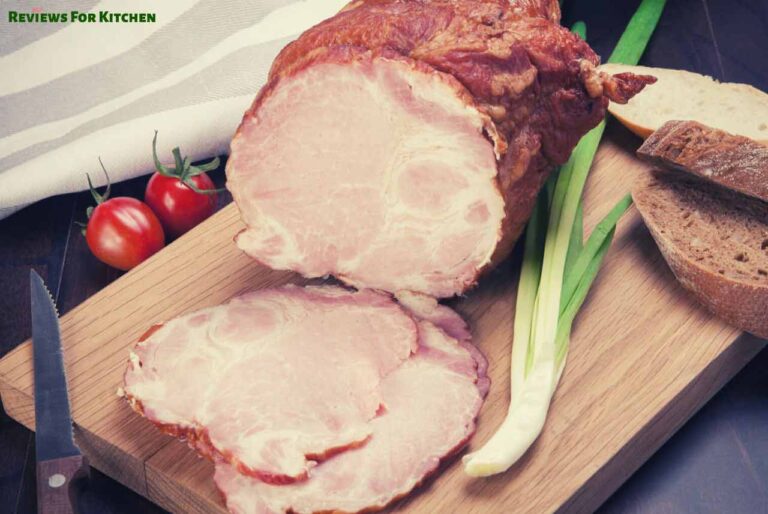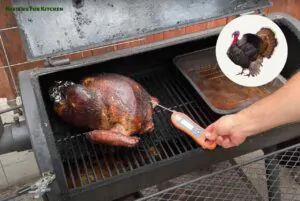Meat slicer isn’t a common feature of home kitchens. Although they are pretty handy and slice up meat in a jiffy, every home cook needs to know how to slice cooked meat thin without a slicer. Make sure you have a sharp chef’s knife or carving knife and that’s essentially the key.
Let your meat rest or if you’ll eat it later, you can let it chill for 30 minutes before cutting. Place on a cutting board, and use a fork to hold the meat. With the knife at a slight angle, cut against the grain in an even motion. Rely on the sharpness of the knife and just go back and forth sawing at the meat.
With evenly cut up thin pieces, you can serve up a beautiful plate that everyone will find appetizing. Keep on reading for a step-by-step guide.
How To Slice Cooked Meat Thin Without A Slicer- Step-By-Step Guide
You can’t always have access to a slicer. Learning to cut up meat thinly with just a knife the old-fashioned way is going to come in handy during dinner time and parties.
Here’s how you can get even slices. But even if you do all of the things we mention, you have to understand that practice is what will make you perfect. Don’t be afraid to give yourself a few tries and soon you’ll be a pro.
1. Start By Letting The Meat Rest
When you’re done cooking meat and it’s hot off the stove, all the juices are concentrated at the surface of the meat. If you cut at this stage, the pressure will make all the juice ooze out of the meat and you’ll be left with less flavor.
Instead, let the meat rest and redistribute the moisture evenly throughout. For a thin cut of meat, like a steak, this can be done in 5-10 minutes. For a roast or an entire bird, you should at least wait 30 minutes. Even then the meat will be hot around the center.
2. Grab A Sharp Knife
A sharp knife makes all the difference when it comes to cutting meat. It will allow you to cut with less pressure, resulting in even, smooth cuts without tearing or ragged edges.
Your two best options are a chef’s knife or carving knife. A chef’s knife is a bit thicker than a carving knife and they will feel different in your hands. Go for the one that feels more natural to you.
It’s also essential that the knife you use for cutting meat has more of a flex to it. You can test whether your knife has a nice give by pressing the pointed end against the counter.
3. Secure The Meat
Place the meat on a non-slip cutting board. You can place a wet paper towel underneath the board to make it stop slipping in case it’s not slip-proof.
If you’re slicing a small cut of meat, you can hold the meat in place with your non-dominant hand or a small fork. Keep your finger curled inside, to protect from accidental cuts.
For roasted ham or beef, whole cooked birds, you need a carving fork to hold the meat in place. There’s no need to stick the whole thing inside, as long as you get a firm grip you’re fine.
4. Position Your Knife For A Cut Against The Grain
It is important that you cut against the grain. This gives you pieces that are tender and easy to chew as the fibers of the meat are cut shorter.
It is easier to identify the grain in bigger pieces of meat by just visually inspecting it. You may not be able to tell with steaks, in that case just cut a small piece and peek at the fibers. Visualize the cuts you’ll make and place your knife accordingly.
5. Slice
Holding the knife at a slight angle, start cutting the meat. Don’t press down too hard, instead do a sawing motion. Move the blade back and forth and the sharpness of your blade will do the magic.
Keep an eye on the slices. Make sure they’re even. The thickness of cooked meat is usually preferred to be at 1⁄4 inch to ⅛ inch. The best thickness for your cut depends on what you plan on using the meat for.
There you have it. Nicely sliced pieces of meat!
If you’re serving bigger cuts of meat, let’s say a brisket, you can slice half of it and leave the other half uncarved. Place the sliced pieces against the unsliced half on the serving dish. This makes it look much more presentable.
You can also read: What Size Grinder Plate For Hamburger | 3 Best Recommendation
Choosing The Right Knife For You - Chef’s Knife Vs. Carving Knife
Slicing cooked meat calls for a handy, sharp knife that has a nice flex to it. A chef’s knife or a carving knife are the best options. They have a long blade with an easy to grip thin handle that is perfect for meat slicing but versatile enough to come in use frequently in the kitchen.
Chef’s Knife
The chef’s knife has a broader blade that ends in a tapering sharp point. It’s usually 8-10 inches long. You can cut large cuts of meat like briskets or roasts as well as smaller ones like steaks.
For regular use around the kitchen, these knives can handle chopping, dicing, and mincing like a pro. You can cut up all sorts of vegetables, fruits alongside meat.
Carving Knife
A carving knife, on the other hand, doesn’t have such versatile usage but it rather specializes in cutting meat and poultry. The narrow, pointed blade comes with a straight and thin cutting edge that allows for precise, thin, and clean cuts.
The length of the blade is about 8 to 14 inches. It’s easy to maneuver and you can cut up roasts, turkeys, and hams without any difficulty with its thin blade like hot knife slicing through butter.
If you cook a lot of meat of different sizes and cuts, then you should invest in a good quality carving knife. But in case you are looking for a versatile knife that you can use for pretty much everything, a chef’s knife is the clear winner.
As long as you are comfortable with the knife and it fits nicely in your hand offering a sharp blade, you’ll do great with either kind. After some practice, you won’t need a thin meat slicer at all to cut up even slices.
How To Identify The Grain of The Meat? Pro-Tips To Level-Up Your Meat Slicing Game
As we have already mentioned, cutting against the grain makes it a much more pleasurable experience to eat meat as the meat is easier to pull apart with your teeth. Here are some tips to identify the grain accurately.
- Most of the time, looking at the meat is enough to tell you the alignment of the fiber. Look for striations or visible parallel lines. You can spot them more easily in bigger pieces. For smaller cuts you may need more to go by.
- Feel for bumps and ridges. The grain will run parallel to the bumps you feel.
- If you’re still not sure, make a small cut perpendicular to the length of the meat on one end. That way, you can take a look at the direction in which the fibers run.
- Remember, that the fiber doesn’t necessarily run in the same direction throughout a cut of meat, especially, when the cut is big. The grain will change direction when you move to another part of the meat when it comes to roasts, briskets or other larger cuts. You have to adjust your knife accordingly, always slicing against the grain.
Here’s a video on how to thinly slice cooked meat against the grain.
You can also read: What Size Grinder Plate For Hamburger | 3 Best Recommendation
Final Words
Hopefully our guide on how to slice meat thin without a slicer has helped you take your skills in the kitchen further.
To summarize, here’s how to slice meat thin: you need to rest the meat before cutting, place the meat on an even surface and secure it firmly with a fork, identify the grain and prepare to slice against it. Slice back and forth in a sawing motion with only moderate pressure, relying mostly on the sharpness of your blade.
Nicely sliced meat can make for a more flavorful sandwich, salads, tacos, rice bowls, or whatever other dish you prefer. However, you may need to get in some practice before mastering the technique.
You May Also Like To Know
- Using KitchenAid Mixer To Mix Meat – Effective & Easy 4 Steps
- Best Food Processor For Emulsifying Meat With Buying Guide
- Best Meat Slicer For Jerky | Ensure Thinner But Faster Slicing
- Best Meat Grinder Attachment For KitchenAid | Snuggly Fit & Faster Operation
- 5 Best Meat Slicer Under $100 Without Compromising Quality
- Best Meat Grinder For Wild Game – Deer, Elk, Bison, & Moose
- What To Mix With Venison When Grinding | Know Exact Fat & Meat Ratio
- What Size Grinder Plate For Hamburger | 3 Best Recommendation
- How To Sharpen A Meat Slicer Blade By Hand | Easiest Guide
- What To Mix With Venison When Grinding | Know Exact Fat & Meat Ratio
- Minced Meat vs Ground Meat | Difference, Similarities & Price
- Lem Vs Cabelas Meat Grinder | Here’s The Best Unbiased Answer












